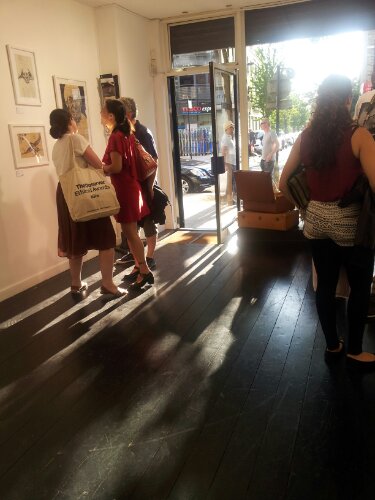Your degree or masters is over. You’ve had your final show and had fair to outstanding feedback. It’s official, you’re an artist. Now what?
There is an almost pathological obsession as an artist to have your work displayed in a gallery. It is the pinnacle of being a ‘real’ artist, the grande finale of an artist’s work. But how does art get into galleries? What do curators look for when selecting art for exhibitions?
Curators scour degree and round up shows looking for talent, but the internet has also become a useful research tool for discovering new talent. Curators actively seek out new artists, keeping abreast of emerging artists and what established artists are doing. They also get a lot of referrals and unsolicited submissions from artists. As you can appreciate, the art world is a massive domain, finding your artistic needle in such a haystack is a mammoth task.
‘There seems to be a gap between artists and getting their work into galleries, between having work to display and displaying it. What artists need to understand is that the market is incredibly competitive and taking unsolicited submissions is extremely rare’, explains Michael Keenan, co-founder of Studio 1.1 in Shoreditch. ‘Most galleries have a finite amount of artists they can handle and galleries will only start looking for new talent when they have a gap to fill’.
This may seem really bleak for emerging artists, but there are ways of making your submissions appealing enough to survive rejection. Don’t be one of the many artists who simply send a mail shot out to galleries without getting to know the spaces or the curators. As you can imagine, this is extremely annoying to busy galleries.
‘It’s a bit like a job application. You’re perfectly well qualified. You send off hundreds of applications and you don’t get the job and someone else does, and they seem as qualified’, explains Mark Jackson, co-founder of the IMT Gallery in Tower Hamlets. ‘You should tailor make your submission, not your work, to the gallery’. This means personalising each gallery submission, which can be a lengthy process. However, it is a good way of determining which galleries will most likely accept your work and you’ll have a better understanding of what a range of galleries are looking for.
Curators do their research, you should do yours too. Get to know the gallery, what work they exhibit and what artists they work with. ‘Think carefully about what it is you are looking for in a gallery. Find out who the curators are and get to know their tastes, not to manipulate your art to fit into the gallery, but to ensure the gallery is a good fit for your work’. advises Josephine Breese, co-founder of Breese Little Gallery in Clerkenwell.
Remember that at the heart of the gallery is the curator and bare in mind that curating is a very personal process. ‘In many ways it is quite a selfish thing’, Josephine explains. ‘We are always looking for artists who we find interesting, but it is definitely based on gut instinct’. A curator has a multifaceted, complex role in the gallery. They are caretakers, mentors, agents, collectors and also essentially creatives. Yet, as a collector, personal preference will ultimately decide what art makes its way into the space. However, there are other factors.
‘I can’t handle working with prima donnas’, explains Keran James, also co-founder of Studio 1.1. ‘We have a genuine love for the work and the artist behind it, but we work with artists for a long time, regularly meeting with them and visiting their studios. A good working relationship is very important, because we’re about supporting the artist to do what they want to do’.
As an artist you should be prepared to work for a long time with a gallery and a good rapport must be nurtured between you and the curator. Galleries find this relationship vital to getting exhibitions right. ‘As a curator it is our job to allow the art to present the artist in the best way possible and give them the best experience of showing their work, because they are the ones who sat in their basements for the last year and half creating’, Josephine points out.
Feel secure in the knowledge that galleries do keep waiting lists for artists they want to work with, so it may take some time for them to contact you when they have a slot for a show that will suit you. But don’t sit around waiting for the phone to ring. As Mark suggests, ‘Be creative about how you show your art, from showing work in your living room, to pop up galleries in the park. Consider working with other artists and doing group shows. Get your art out there any way you can’. Out in the real world and not just in the virtual one.
‘Have a website, but don’t just tell galleries to look at it. Have it for when galleries research you. There is nothing worse than being referred to an artist and not being able to find their work with a simple web search’, advises Michael.
The best advice curators can give is to spend time perfecting your art, network with other artists, visit galleries to get to know the space and introduce yourself to curators. Find sympathetic galleries that are willing to help you develop without ‘selling your soul’. Be willing to accept criticism in order to grow, after all galleries rely on artists to fill their space and would never give advice at the detriment of the artist. Don’t be despondent, because above all else patience is key to making it into galleries, so be prepared to be a struggling artist as part of the process.





